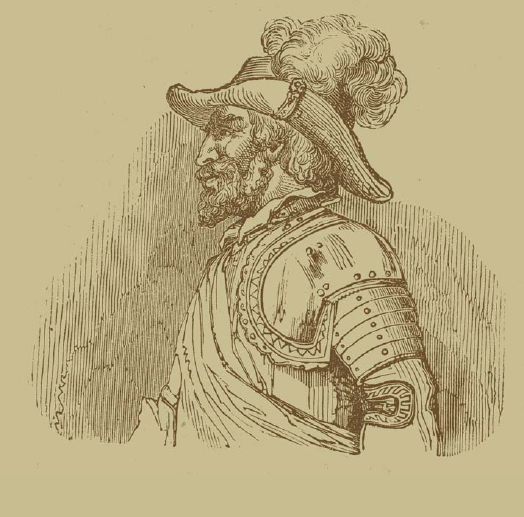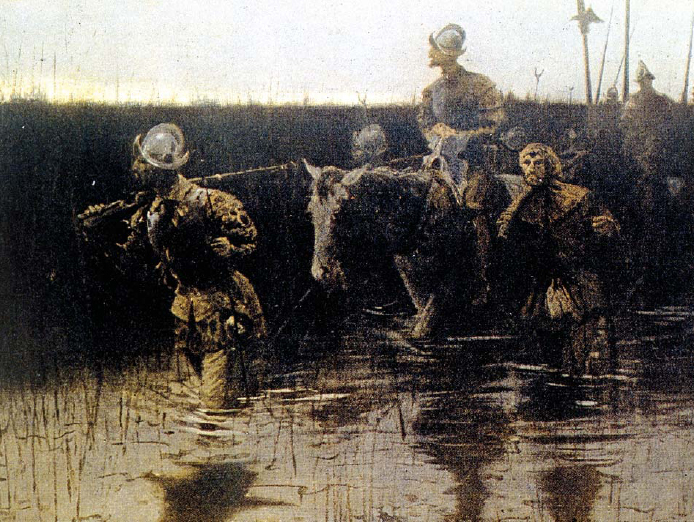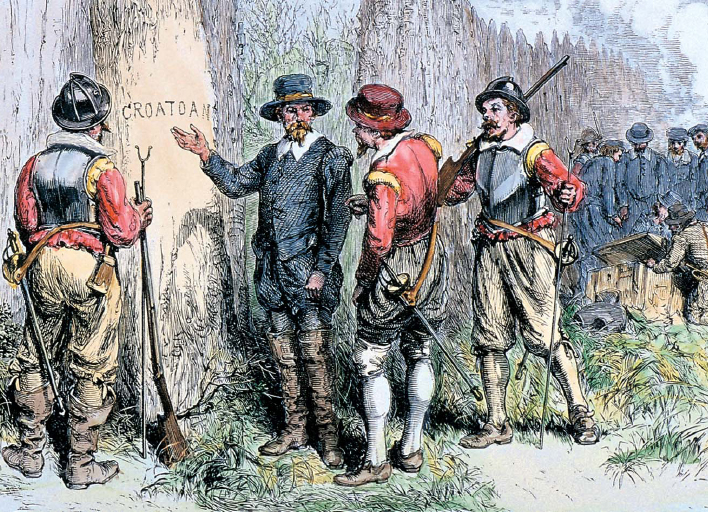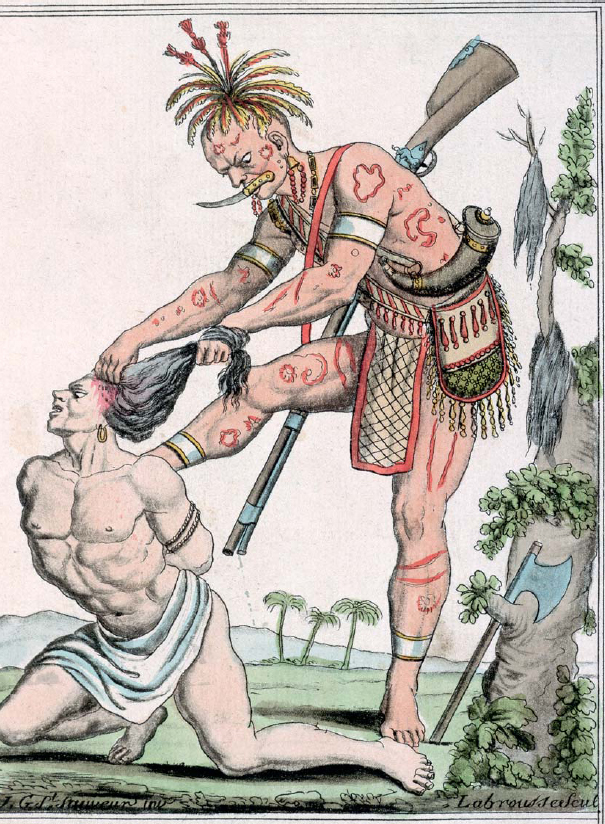The territory now known as the southeastern United States was more of a challenge than the Europeans had expected. The terrain was somewhat different from what they had found in Mexico, Central America, and South America. The people they found living there were different as well. Unlike the dominant Aztec and Inca civilizations, there were many unique cultures spread throughout the southeast. A conquest would require more than just defeating one emperor like Montezuma or Atahualpa.
The Spanish conquistadors started in a place they named Florida, meaning Flowery Land. The Spaniards used the word “Florida” to describe not only the state that still bears that name, but also much of the surrounding area. A small group of French adventurers made an attempt to settle in Florida, but the Spaniards quickly destroyed their settlement. This demonstrated yet another important difference from previous explorations: The Spanish would have to compete with European rivals.
The first conquistador in Florida was Ponce de León in 1513. Legend holds that Ponce de León was looking for a so-called fountain of youth, but in reality, he was only searching for gold and riches, just like the other conquistadors. Stories of brutal Spanish conquests to the south had arrived in Florida before León, so he was not welcomed there. In fact, the native people of the Calusa Nation quickly drove him away. Ponce de León returned to Florida in 1521 with 200 soldiers, but again was defeated. This time, de León had been wounded, and he died a short time later in Cuba.
THE PERILOUS JOURNEY OF CABEZA DE VACA
THE PERILOUS JOURNEY OF CABEZA DE VACA Alvar Núñez Cabeza de Vaca was on one of the doomed rafts that set sail from Florida. He was the expedition’s treasurer and kept a detailed diary. De Vaca’s raft capsized during a storm. He and several other exhausted Spaniards washed up on the Gulf coast of Texas, where local Indians found them.
In his diary, Cabeza de Vaca describes what the Indians did next: “Because of the extreme coldness of the weather, they caused four or five very large fires to be placed at intervals, and at each they warmed us; and when they saw that we had regained some heat and strength, they took us to the next so swiftly that they hardly let us touch our feet to the ground. In this manner we went as far as their habitations, where we found that they had made a house for us with many fires in it.”
The Spaniards were worried that they had only been saved so that they could be sacrificed to the Indian gods, but de Vaca then writes: “In the morning, they again gave us fish and roots, showing us such hospitality that we were reassured.” Gradually, the Spaniards made their way westward, acting as traders and medicine men for the Indian tribes they encountered. After a six-year odyssey, Cabeza de Vaca and three of his comrades finally arrived in Mexico.
Pánfilo de Narváez made the next attempt in 1528. His expedition fared only slightly better against the natives. After several months of exploring the hostile territory, Narváez and his men concluded that there was little wealth in this part of the New World. They had exhausted their supplies and were in constant danger. Desperate, they decided to build rafts and sail to the safety of Mexico. A storm scattered the rafts, and most were never heard from again. Only four survivors ever arrived in Mexico, six years after they had left Florida.

Juan Ponce de León, who came to America with Christopher Columbus’s second voyage, had helped to put down revolts by natives on the island of Hispaniola. After he discovered the island of Puerto Rico, he was in charge of overpowering the natives there. However, during his two visits to the mainland of North America, Ponce found the Native Americans more warlike. He was killed by a poisoned arrow on his second trip to Florida in 1521.

Alvar Núñez Cabeza de Vaca gazes over the desert of the American southwest. A member of a doomed Spanish expedition to Florida, Cabeza de Vaca wandered through the southwest for seven years before reaching friendly Spanish settlements in Mexico.
The previous failures to conquer Florida did not discourage a daring man named Hernando de Soto. A former aide to Pizarro during the Inca conquest, de Soto was not intimidated by hostile natives. In May 1539, he boldly sailed into what is now Tampa Bay with an army of 600 men, determined to crush the local Indian tribes. As they marched through Florida, de Soto and his men murdered, stole food, kidnapped chiefs, and raped Indian women. Word quickly spread among the Indian tribes that the Spaniards could be tricked into leaving by telling them that much gold and pearls could be found in a nearby village. This magical village never actually existed, but the Spaniards fell for the trick again and again.
FARMING IN THE NEW WORLD
Europeans were fascinated by the strange and different foods that grew in America. Potatoes, tomatoes, and pumpkins were just a few of the plants that they had never seen before. Native Americans farmed each of these, but no single crop was as important to their culture as corn, or maize, as the Indians called it. Corn was easy to grow, and it produced a high yield. European settlers recognized the value of corn, too, and began farming it shortly after they arrived.
The settlers disapproved of Indian farming methods. Indians did not remove tree stumps from their fields, and often grew several crops mixed together in the same field. Farmers in Europe always kept neat, orderly farms with just one crop per field. By comparison, the Indian way looked messy and disorganized.
However, the settlers did not recognize the benefits of this apparent clutter. Tree stumps helped prevent soil erosion. Different crops growing together enriched the soil. Indian farmers often planted corn, beans, and pumpkins together, each one providing nutrients for the other. Cornstalks provided excellent support for the climbing bean vines, and leaves from both the corn and the beans gave shade to the pumpkins.
De Soto wandered throughout the southeast for three years, searching for wealth that he would never find. During that time, the Spaniards lost over half their men to combat or disease. Finally, in May 1542, de Soto himself became sick and died. His body was laid to rest in the Mississippi River, a river that he is credited with discovering. Just as before, the survivors returned to Mexico with nothing to show for their odyssey but tales of death and destruction.
While the conquistadors had failed in Florida, the Old World diseases that they brought with them were much more successful. As with the Aztecs and Incas, Indians living in Florida had no resistance to smallpox and other viruses. Plagues rapidly spread from village to village, turning them into ghost towns. Most historians agree that European germs did far more damage to Native American cultures than the Europeans themselves ever could.
Farther north, England was also beginning to explore the New World. Just as Spaniards used the word “Florida” to describe a large portion of the southeastern United States, the English used the word “Virginia” to describe an area extending from North Carolina to Canada. Unlike the conquistadors, the English arrivals were more interested in finding a place to live in the New World than in plundering it.
The first English colony was established on an island off the coast of North Carolina in 1585. The Indians who lived nearby called themselves the Roanoke, and so the island came to be known as Roanoke Island. The English settlers realized they would need the Indians’ assistance in order to survive, especially since the colony’s supply ship had sunk in treacherous waters near the island. The Roanoke Indians were friendly and gladly shared their hunting and farming knowledge with the settlers. In return, the settlers gave them gifts of clothing and metal tools. The neighboring communities got along well together, at least for the first few months.
Unfortunately, Roanoke Island was not an ideal farming environment. The soil was poor, and the colonists were soon out of food. At first, the Indians were willing to share their corn supplies with the English, but by the spring of 1586, there was no longer enough corn to share. The English began to starve. Their leader, Colonel Ralph Lane, suspected that a local Indian chief was plotting against the colony. It is not known if this suspicion was correct, but in the end, Lane and a group of soldiers murdered the chief. Starving, and now fearful of retribution from the Indians, the settlers decided to abandon the colony. They left for England on the next ship.
Another attempt was made to colonize Roanoke Island a year later. Once again, the English found they could not farm the land, and became dependent on the local Indian tribes for food. Just as before, they alienated the Indians with an unprovoked attack. This time, when the ships finally arrived, there was nobody waiting to go back to England. In fact, there was no sign of the 110 settlers at all. It did not appear that they had fallen victim to an Indian attack—they just disappeared. The missing settlement became known as the Lost Colony, and white settlers avoided the area for over 100 years afterward.
Despite setbacks, England continued its efforts to establish a colony in the New World. In 1607, a site farther north was chosen and it was called Jamestown. While the Jamestown land may have been more suitable for farming, its first settlers were primarily English gentlemen who did not possess basic farming skills. They, too, had to rely on the local Indians for survival. The Jamestown colony was located in territory controlled by Powhatan, a powerful chief of the Pamunkey Nation, and also the father of Pocahontas.

For much of his ambitious journey through Florida and the American South, Hernando de Soto and his large party of Spanish soldiers was harassed by hostile Native Americans. De Soto brought the trouble on himself by his brutal treatment of the natives he encountered.

Early attempts by the English to establish a colony on Roanoke Island failed. The people of the second colony disappeared from the island sometime between 1587 and 1590. No one is certain exactly what happened to the members of the “lost colony,” but some may have joined local Indian tribes.
Powhatan and his brother Oppecancanough attempted to overthrow the colonists in 1622 and again in 1644. While they were nearly successful in 1622, the number of settlers in the Jamestown colony had increased by 1644. Furthermore, the number of warriors in Powhatan’s group had decreased to a point that they stood no chance of stopping the continued takeover of Indian lands. §

This drawing from a 17th century French book shows an Iroquois scalping a white man. The Iroquois were a powerful confederation of natives in the northeastern region of North America.




